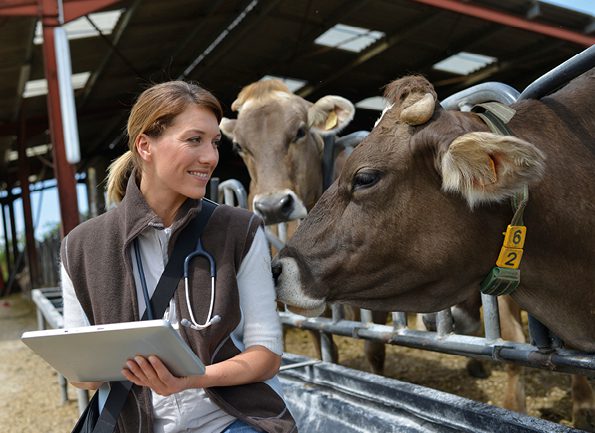Routine Veterinary Testing of Livestock

What does routine testing of livestock involve?
The types of routine tests that are performed on animals intended for consumption vary with the species in question and the regulatory requirements of the country in which it is being farmed. For example, in the UK, it is required by law for all cattle herds to be tested for bovine tuberculosis (TB) as frequently as every 6 months, while in the US, it is recommended that sheep flocks be regularly monitored for ovine progressive pneumonia (OPP).
Routine testing of livestock typically begins with a physical examination by a qualified veterinarian, which includes checking vital signs like breathing, heart rate, and temperature. In addition, samples such as blood, urine, feces, saliva, and tissue biopsy material may be collected for in vitro diagnostic (IVD) testing or analysis at an external laboratory.
The types of analytes that are commonly screened for include bacteria, viral particles, and fungi, as well as a broad range of inflammatory biomarkers. Examples of the latter are c-reactive protein (CRP), which has utility for diagnosing mastitis in dairy herds; procalcitonin (PCT), an acute phase protein that has been used for scoring lameness in sheep; and calprotectin (CP), which is currently being investigated as a marker of intestinal inflammation in pigs.2,3,4
Many familiar assays are used for testing animal samples, including enzyme-linked immunosorbent assay (ELISA), polymerase chain reaction (PCR), lateral flow immunoassay (LFIA), immunohistochemistry (IHC), and flow cytometry. Additionally, hemagglutination assays and hemagglutination inhibition assays are respectively used for confirming the presence of infectious agents and detecting anti-pathogen antibodies.
During a typical hemagglutination assay, test sera is mixed with red blood cells (RBCs) in the wells of a microplate. If the sera contains a pathogen with surface proteins capable of binding the sialic acid receptors present on RBCs, the resultant formation of a lattice produces a disperse red color. A hemagglutination inhibition assay is based on similar principles, but involves adding a known amount of the pathogen to each well, whereby the presence of serum antibodies prevents hemagglutination.
Symptomatic testing
Besides being routine, it is customary for testing to be performed when one or more animals within a herd displays symptoms of ill health. Such symptoms might include diarrhea, coughing, or a skin complaint, or could be more severe, such as a locomotor disorder, stillbirth, or sudden death. Since many animal diseases remain without an effective cure, being able to accurately and rapidly diagnose a health condition is critical to minimize spread.
Organizations such as the U.S. Department of Agriculture (USDA) and the Animal and Plant Health Agency (APHA) in the U.K. have put in place detailed guidelines covering the possible causes of different symptoms, and the types of tests that should be performed when such symptoms are observed.
For example, enteric disorders in cattle could potentially be due to infection with agents including Salmonella coccidiosis, Mycobacterium avium sp. Paratuberculosis (the cause of Johne’s disease), or bovine viral diarrhea (BVD) virus, and might be diagnosed using techniques such as ELISA and/or PCR to analyze stool or blood samples5.
In contrast, bovine abortion or stillbirth could result from infection with agents including Chlamydia, Brucella, or Toxoplasma gondii, the presence of which might be confirmed via immunocytochemical analysis of placental samples, or using techniques such as ELISA, PCR, or latex agglutination to test maternal blood5.
Supporting animal disease research
Jackson ImmunoResearch specializes in producing secondary antibodies for life science applications. Our product portfolio encompasses secondary antibodies conjugated to horseradish peroxidase (HRP), alkaline phosphatase (AP), and an extensive selection of fluorescent dyes, which can be used for detecting primaries raised in hosts including cows, pigs, and sheep.
References
- Pekar JE, Magee A, Parker E, et al. The molecular epidemiology of multiple zoonotic origins of SARS-CoV-2. Science. 2022;377(6609):960-966. doi:10.1126/science.abp8337
- Lee WC, Hsiao HC, Wu YL, et al. Serum C-reactive protein in dairy herds. Can J Vet Res. 2003;67(2):102-107./
- El-Deeb W, Abdelghani MA, Alhaider A, Fayez M. Immunological response of lame sheep to clinical interdigital dermatitis and footrot: Procalcitonin, acute phase proteins, and pro-inflammatory cytokines. Comp Immunol Microbiol Infect Dis. 2022;90-91:101899. doi:10.1016/j.cimid.2022.101899/
- Barbosa JA, Rodrigues LA, Columbus DA, et al. Experimental infectious challenge in pigs leads to elevated fecal calprotectin levels following colitis, but not enteritis. Porcine Health Manag. 2021;7(1):48. Published 2021 Aug 24. doi:10.1186/s40813-021-00228-9/
- http://apha.defra.gov.uk/documents/surveillance/sub-handbook.pdf
